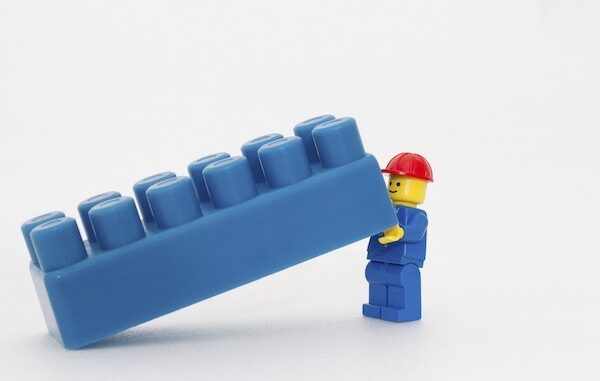
Did You Know? is a design trivia segment brought to you by DesignTAXI in which we get to the surprise candy of well-loved designs or brands. Stay tuned for more history and behind-the-scenes tidbits as we grow this column.

Image via MeskPhotography / Shutterstock.com
Its ability to be knocked over to create something entirely new provides a lesson no matter the period. Today, it could inspire businesses struck by financial uncertainty and the pandemic. But it could have very well been a metaphor for the creation of the LEGO, along with the tragedies that forced LEGO founder Ole Kirk Christiansen to overturn his worldview.
After two fires—the first taking out his shop in 1924 and the second demolishing his factory in 1942—and a loss of available resources after World War II, Christiansen turned to plastic and began experimenting with the manufacture of toys.

Image via Windell Oskay / Flickr (CC BY 2.0)
Building Blocks
Before even getting close to inventing the LEGO, Ole Kirk Christiansen was a carpenter happy to build wooden furniture like ladders, ironing boards, and stools. Alas, just as he was seeing beginnings of a successful future from his craft, his sons accidentally set some wood chips in his shop on fire, which wiped out not only his place of business but also the family home.
In 1942, a second fire engulfed Christiansen’s factory. There was also a shortage in traditional manufacturing materials for consumer goods after World War II. This time, however, Christiansen was armed with the resilience and preparedness to rise from the situation. He turned to plastics as an affordable alternative for production.
By 1949, the company was ready with its first LEGO-like toy, the Automatic Binding Bricks.

Image via LEGO
The LEGO block, as you know it, arrived in 1955. If you tried connecting a modern-day LEGO to the very first brick, you’d see that they fit perfectly.
Played with Fire (and Fire, and Even More Fire)
Christiansen died in 1958. By a stroke of fate, a third fire burned down LEGO’s wooden toy warehouse in 1960. This was the final nail in the—obviously wooden—coffin for the brand; it was when LEGO finally decided to move on from wood altogether and construct something solid out of plastic bricks.
And It Still Stacks Up

Image via LEGO
LEGO’s tenacity through tragedy has been paramount to its success. In 2000, both Fortune magazine and the British Association of Toy Retailers named it the ‘Toy of the Century’. It is also said that there are an average of 80 LEGO blocks for every person on the planet.
If not for the fires, LEGO might not have assumed the role of architect for the imaginations of kids past and present. Incidentally, its name—short for “play well” in Danish—also means “I put together” in Latin, a piece of trivia unbeknownst to Christiansen for years.
[via

Leave a Reply